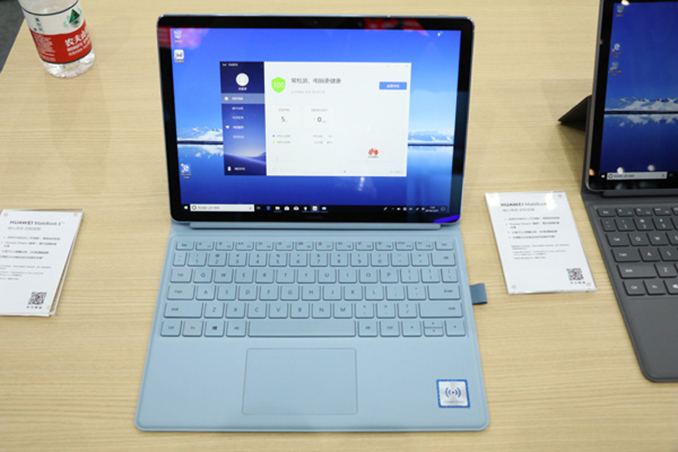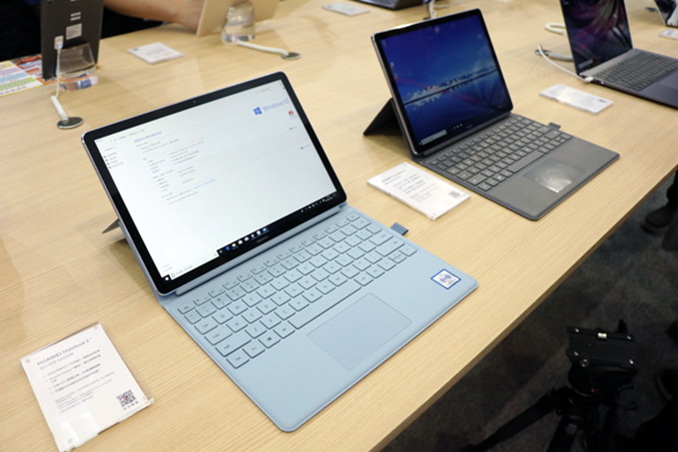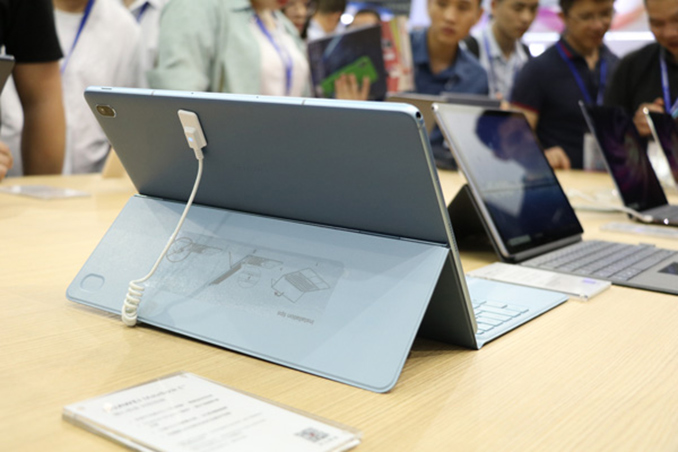Huawei Readies Windows 10 Laptop Based on Qualcomm Snapdragon 850
by Anton Shilov on April 11, 2019 4:00 PM EST- Posted in
- Laptops
- Qualcomm
- Huawei
- Notebooks
- 2-in-1
- Matebook E
- Snapdragon 850

Being a relatively new maker of laptops, Huawei is trying to address high-end and niche markets to gain share, avoid direct competition with numerous rivals at the same time, and preserve its profit margins. With numerous ultra-portable Intel Core-based notebooks in its arsenal, Huawei is working on a Windows 10 on Snapdragon 2-in-1 PC for those who want an always-connected machine.
The Huawei Matebook E 2019 is actually even more portable than the company’s existing offerings. The convertible 2-in-1 notebook comes equipped with a 12-inch display featuring a 2160×1440 resolution, 400 nits brightness, and a 3:2 aspect ratio. The chassis of the tablet (as well as its kickstand) is made of an unknown metal alloy and is 8.5 mm thick, which is a tad thicker when compared to other offerings in this segment. Meanwhile, the tablet itself weighs 690 grams without its keyboard cover and about a kilogram with it, bringing the weight of the whole system to the level comparable with ultra-light notebooks. Speaking of keyboard, it has a relatively large touchpad and an NFC chip to enable Huawei’s Share OneHop service, but no backlighting. Besides, it can hold Huawei’s M-Pen stylus.
The Matebook E is based on the Qualcomm Snapdragon 850 SoC (four Kryo 385 cores at 2.96 GHz, four Kryo 385 cores at 1.7 GHz, Adreno 630 GPU) which is accompanied by 4 or 8 GB of LPDDR4X memory as well as 128 or 256 GB of USF NAND flash storage (it is unclear whether it is expandable using a microSD card). Since we are dealing with a machine powered by a platform originally designed with mobility and connectivity in mind, the Matebook E supports everything you come to expect from an Always Connected PC (ACPC), including the X20 LTE modem (Cat 18, 5CA, 4x4 MIMO, up to 1.2 Gbps DL, up to 150 Mbps U, 802.11ac Wi-Fi, and Bluetooth 4.1. Interestingly, the Matebook E is outfitted with an eSIM, but also has a slot for a regular nano SIM card.
The tablet also has a USB Type-C connector, a fingerprint reader, two stereo speakers, and a 3.5-mm TRRS audio jack. Obviously for a 2-in-1 form-factor, the Matebook E feature the same set of sensors as regular tablets, including an accelerometer, a gyro, a light sensor, and so on. As for battery, it has a built-in 36.3 Wh battery that can last up to 20 hours.
When it comes to imaging, the 2-in-1 notebook has a 20 MP main cam with autofocus and a LED flash, as well as a 5 MP camera for selfies.
Huawei plans to launch its Matebook E 2-in-1 convertible in China already next month, but it is unclear when and if the company intends to release it on other markets as well.
| Specifications of Huawei's Windows on Arm 2-in-1 | ||
| Matebook E 2019 | ||
| Display | 12-inch, 2160×1440 216 PPI |
|
| CPU | Qualcomm Snapdragon 850 4 x Kryo 385 at 2.96 GHz 4 x Kryo 385 at 1.7 GHz |
|
| Graphics | Adreno 630 GB | |
| RAM | 4 or 8 GB LPDDR4X | |
| Storage | 128 or 256 GB UFS | |
| Wi-Fi | 802.11ac Wi-Fi | |
| Bluetooth | 4.1 | |
| WWAN | Qualcomm X20 Gigabit LTE Cat 18, 5CA, 4x4 MIMO, up to 1.2 Gbps DL, up to 150 Mbps UL |
|
| USB | 3.0 | 1 × Type-C |
| Cameras | Front | 5 MP |
| Rear | 20 MP | |
| Other I/O | Microphone, stereo speakers, audio jack, trackpad, etc. | |
| Battery | 36.3 Wh | |
| Battery Life | 20 hours | |
| Dimensions | Width | ? |
| Height | ? | |
| Thickness | 8.5 mm | |
| Weight | Tablet | 690 grams |
| Tablet+KB | ~1000 grams | |
| Price | ? | |
Why Snapdragon and not Kirin?
Ian: When we were at Mobile World Congress, I put it to HiSilicon if they were planning to build a chip for Windows based notebooks with the name Kirin. They said that they were not, for the simple reason that the market is not yet mature. They are more than happy to let other chip manufacturers build a market first, before they insert their own hardware, and would potentially join a mature market, but not at this time. Despite this, this new product shows that Huawei is willing to at least dip its toe into the water with the already verified solutions on the market, even if it isn't Huawei's own chips just yet.
Related Reading
- Samsung Unveils Galaxy Book2: 12-Inch, Snapdragon 850 with X20 LTE, 20 Hrs
- Lenovo Announces Yoga C630: The First Windows on Snapdragon 850
- Qualcomm Announces Snapdragon 850: A Second Generation For Windows
- Lenovo’s Miix 630 Snapdragon 835-Based 2-in-1 Now Available
- HP’s Snapdragon 835-Based Envy X2 2-in-1 Available for Pre-Order, Starts at $999
- Lenovo Unveils Miix 630 2-in-1: Windows 10 S, Snapdragon 835, Gigabit LTE, 20 Hrs
- ASUS Announces the NovaGo (TP370): A Snapdragon 835 based Windows 10 PC
Source: NotebookItalia.it (via Liliputing)













39 Comments
View All Comments
FSWKU - Thursday, April 11, 2019 - link
So, because it's running Windows, you're unable to use the normal applications you'd expect to have on a tablet.But because it's an ARM-derived architecture, it's not compatible the x86/64 applications you'd expect to be able to use on Windows, meaning you're stuck with whatever they decide to build and put on the Windows Store.
What's the point of this again? It looks like the worst of all worlds.
peterfares - Thursday, April 11, 2019 - link
Windows 10 on ARM has supported x86 programs through a compatibility layer since its release. Not x64 programs though, but most things are available in x86.FSWKU - Thursday, April 11, 2019 - link
Then you have the performance hit from translating the instructions into something the Snapdragon knows what to do with. They can claim "near native" performance all they want, but there's always going to be a slowdown when translating instructions between two different architectures. It might not be a dealbreaker for some people, but it WILL be noticeable.Not to mention the inevitable hit to that "up to 20 hour" battery life if you're making the CPU work harder all the time.
Calista - Thursday, April 11, 2019 - link
A lot of the apps we can expect to be used on a solution such as this have very low performance demands. If you need high performance - pick something else. So what if some things will be a bit slow, as long as 98 percent of the time I spend are with programs running natively on ARM I would be perfectly happy. Especially so if it means double the battery life as compared to x86.HStewart - Thursday, April 11, 2019 - link
The big problem with these device that most consumer - not technical geeks - are naïve to the designed of these devices and will attempt to run their x86 application and they will think it problem with the application but it actually because of emulation.But I believe this is only temporary, Intel Lakefield has several advantages over these ARM emulators - or can we say Windows RT 2.0, Lake field combines a Sunny Cove core which is unlike Skylake cores and has more cache and execution units. I find to most interesting about Sunny Cove is that Intel added addition store unit on process - so instead having two load units and single store unit Sunny Cove has two of each and most important it appears in different frame of execution. I believe with limited knowledge from 80's of CPU design at Georgia Tech that this designed allow execution in parallel better on the same CPU. I would be curious about the performance increase in Sunny Cove architecture alone, but would expect it is significant.
Also Lakefield has 3 smaller cores - these are likely unlike Atom's today but a next generation but designed for efficiency. I would hope with modifications of the kernel this means the background tasks will run on these cores while the main processor runs on the Sunny Cove based core.
Also significant about the Lakefield is the packaging which is next generation of EMiB but this time Intel has gone vertical which allows more components in smaller space.
But I think that the real advantage of Sunny Cove will be seem in higher end processors - but that is yet to be seen.
The funny thing about Windows for ARM ( or Windows for Qualcomm ) is Microsoft, why have Microsoft not release a laptop with it - maybe they don't want to relive the bad reception of the earlier version of which Windows RT.
Raqia - Thursday, April 11, 2019 - link
Intel has lost the process lead, and it will show more and more as time goes on as they resort to more expensive packaging solutions to try to close the gap by reallocating older process node capacity alongside delayed or not fully functional newer process nodes. I do think it's compelling for higher end solutions as you say, but Intel has already lost the lower power segment and seems poised for further losses. You emphasize emulation but the primary use case of such laptops will be the browser (https://xkcd.com/1367/), and both Firefox and Chrome will have a native ARM path very shortly (https://www.anandtech.com/show/14201/firefox-beta-... https://twitter.com/sinclairinator/status/11149820... This will be comparable in performance to Intel's solutions but far more compelling in energy efficiency.For this form factor, portability, power efficiency and connectivity are more compelling than power, and I think it's better to think of these devices as essentially ARM tablets with x86 compatibility as a feature. Even if you want actual performance, you wouldn't go to an Intel laptop with a similar form factor and power envelope; instead, you'd go to a dramatically different power envelop with a desktop.
HStewart - Friday, April 12, 2019 - link
I think you are talking about the past - Lakefield is a future cpu.,ARM is good for some tablet and phones - this is majority a gaming site would you trust one o latest games to ARM CPU - no.
Opencg - Sunday, April 14, 2019 - link
process lead doesnt matter as much as people think anymore. if they dont get a new node into major production soon they will be in trouble but with a solid architecture they can easily compete with 3 or 5 nm on 10nmZoolook13 - Monday, April 15, 2019 - link
They have to get 10nm up and running first, and no it isn't until they can ship larger processors with working integrated gpu's.ajp_anton - Friday, April 12, 2019 - link
You mentioned that Lakefield has several advantages, but you don't mention a single one.You talked a lot about Sunny Cove vs Skylake, but those are higher power (as in electrical power) cores, so not really a comparison. You could just as well claim that an i9-9900K is better than this AMR chip.